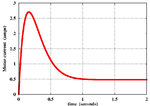T
treez
Guest
Hello,
We have to design a universal input offline SMPS to supply the Whale Gulper 220 Pump.
Our SMPS will have a settable output voltage, either 12V or 24V.
The datasheet for the pump just says "24V, 2A" or "12V, 4A".
Though we do not know if this has high current peaks or not.
Do you know what the current waveform will be like?....will it have high peaks, and what will the peaks be? What will be the frequency of the drawn current?
The customer gave us a sample waveform, which shows the current into a 24V pump. -It actually shows a scope shot of
the voltage across a 100milliohm sense resistor in series with this pump....the waveform was a 2Hz (sort of) sine wave, (with a DC offset, so not negative going) which had a 5 Amp peak
bit which lasts for about 100 milliseconds.
We have no idea if the scope used was calibrated or if it was accurate.
I am of the impression that scope voltages are generally not accurate...so we have no idea if the peak current on this waveform is accurate or not.
Do you know what the current waveform into this pump will be like?
Whale Gulper 220 pump datasheet:
https://www.defender.com/pdf/503200_Whale_Gulper220.pdf
Whale gulper 220 pump details
https://www.defender.com/product.jsp?path=-1|51|2234226|2234234&id=1777934
We have to design a universal input offline SMPS to supply the Whale Gulper 220 Pump.
Our SMPS will have a settable output voltage, either 12V or 24V.
The datasheet for the pump just says "24V, 2A" or "12V, 4A".
Though we do not know if this has high current peaks or not.
Do you know what the current waveform will be like?....will it have high peaks, and what will the peaks be? What will be the frequency of the drawn current?
The customer gave us a sample waveform, which shows the current into a 24V pump. -It actually shows a scope shot of
the voltage across a 100milliohm sense resistor in series with this pump....the waveform was a 2Hz (sort of) sine wave, (with a DC offset, so not negative going) which had a 5 Amp peak
bit which lasts for about 100 milliseconds.
We have no idea if the scope used was calibrated or if it was accurate.
I am of the impression that scope voltages are generally not accurate...so we have no idea if the peak current on this waveform is accurate or not.
Do you know what the current waveform into this pump will be like?
Whale Gulper 220 pump datasheet:
https://www.defender.com/pdf/503200_Whale_Gulper220.pdf
Whale gulper 220 pump details
https://www.defender.com/product.jsp?path=-1|51|2234226|2234234&id=1777934
Last edited by a moderator:
